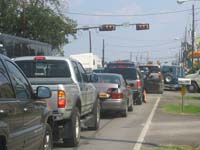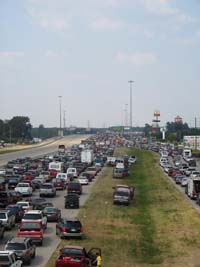Evacuation Checklist
The goal of your evacuation checklist is to make sure you are prepared in case of an emergency that necessitates evacuating your home. The goal is simply to make sure that regardless of the situation, you are prepared with a plan and a checklist that allows you to evacuate with your loved ones as efficiently and safely as possible.
Any evacuation plan must consider the following disaster scenarios:

- Natural disasters
- Fires
- Floods
- Storms
- Earthquakes
- Industrial Accidents
- Nuclear
- Chemical
- Biological
- Military Attacks
- Traditional Invasion
- Chemical and Biological Warfare
- Nuclear Warware
- Terrorist Attacks
- Pandemic
Do I Really Need To Be Ready for Evacuation?
To answer this question, click on the following link of mass evacuations and look at the 21st century section.
This section includes floods, hurricanes, earthquakes, nuclear accidents and the 9/11 terrorist attacks. Each of these situations included mass evacuations that overall probably went as well as could be expected but each of these had different outcomes on an individual basis. If a disaster happens and you are out of gas in your car, things likely won’t go well.
The simple answer to the question, is that any family or group that had planned for the possibility of evacuation will be a lot better off than those who are caught off guard.
Deciding Whether to Evacuate

Except for exceptional circumstances, you will have some period of time where the choice is yours. If you think evacuation is likely, leaving sooner will allow you to evacuate rapidly and efficiently.
More Info on Emergency Evacuation
The Plans
For any evacuation, you need to have the following plans in place and make sure your loved ones are all familiar with the details.
- Communication Checklist
- Supply Checklist
- Transportation Checklist
- Evacuation Checklist
Communication Checklist
The point of the communication plan is to make sure you and your loved ones will know what to do when the time comes. A disaster can happen at any time; when you are asleep, when you and your loved ones are going about your day at work, school, shopping or what have you.
When a disaster happens, your first order of business is to make sure you and your loved ones can regroup to be ready for the evacuation. The simple fact is that you likely won’t leave when you should if you have are missing someone important.
- Initial Contact Method - usually cell phone or land line
- Primary Meeting Point - usually your home
- Secondary Meeting Point - a safe alternate location
Make sure you have a communication plan that includes a series of easy to remember contact points for all situations. Start by setting an initial contact where every member of your family contact makes contact with each other and coordinates a regrouping to proceed with the evacuation. Normally this will be by cell phone or land line. If circuits aren’t busy and this works, then you can proceed with the evacuation after you are all together.
Your primary meeting point, usually your home, will be the location to regroup if you can’t make initial contact with one or more members of your family. In this situation, you will agree to meet at the primary point as soon as possible.
Your secondary meeting point is the alternate location in case your primary meeting point is not reachable. For this reason, the secondary meeting point should be far enough away that it likely won’t be encumbered by the same problems. For example, if your primary meeting point is in a flood zone, the secondary should be on higher ground. It should also be far enough that you will have alternate routes of access. Finally, it should be a place where you can safely wait till your family is able to assemble.
Supply Checklist
You should have “go” bags for each member of your family packed separately. Each “go” bag should have the following items:
- water (small bottles) and non-perishable foods and snacks
- battery or crank radio and flashlight (bring extra batteries if battery-powered)
- first aid kit
- waterproof copies of important documents - either laminated or in waterproof-pouch)
- prescription information
- a whistle
- mylar blanket
- copies of house and car keys
- small quantity of cash in small bills
- toilet paper, toothpaste and other required personal hygiene items
- any special personal needs (baby supplies, pet supplies, etc)
Each pack should be located where it can be easily reached when its needed.
Transportation Checklist
You should get in the habit of keeping your gas tank full. You might consider topping-off your tank when you get to three quarters of a tank. This will change depending on your commuting patterns but you get the idea. If you remember the gas lines of the 70’s you know what i’m talking about when I say the worst thing you can do is try to stop at the local gas station in case of a massive evacuation.
- top off your gas tank regularly
- make sure your tires, brakes are properly maintained
- get regular oil changes
- plenty of room for all members of the family
Make sure you have a vehicle in good mechanical shape and enough room for your entire family. Failing that, multiple vehicles will work but be sure you stay together during the evacuation.
Evacuation Checklist
This part of the plan is the overall evacuation checklist or your action plan. Understanding the phases of an evacuation will help you plan your personal checklist to take advantage of stages of the overall evacuation.
Evacuation can be thought of as two major phases: pre-movement and evacuation.
The pre-movement phase is broken down into four stages.
- detection of evacuation scenario
- decision to evacuate
- evacuation alarm
- reaction time

Each of these stages will vary dramatically depending on the type of disaster. During a hurricane, for example, these stages may take days as the storm approaches and a determination is made about the likelihood of impact with your location. In this case, the evacuation will likely be less compressed and more, relatively speaking, organized.
In the case of a sudden disaster such as a terrorist attack, these stages may be compressed and more chaotic as a direct result of the ensuing panic.
During the actual evacuation phase, there are two stages.
- movement to area of refuge
- transportation
In some scenarios, the area of refuge will be specific and easy to identify such as local safe spots such as local public schools and other government refuges. Other scenarios will include a general evacuation out of the area to locations of individual preference.
In either situation, you need to think through the aspects of the evacuation to make sure you are on schedule or even ahead of the schedule if possible. For example, if you believe evacuation is likely, getting out ahead of time and prior to the rush will save you lots of pain and frustration.
http://www.ready.gov/evacuating-yourself-and-your-family